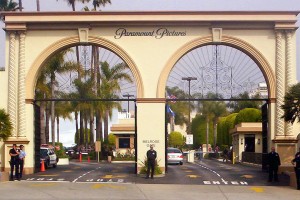 As I sat in Michael Okuda’s office at Paramount Studios in December of 1993, politely declining an offer to work on Star Trek, a not-so-quiet voice in the back of my head was screaming at me: “Jon, are you frickin’ NUTS?????”
As I sat in Michael Okuda’s office at Paramount Studios in December of 1993, politely declining an offer to work on Star Trek, a not-so-quiet voice in the back of my head was screaming at me: “Jon, are you frickin’ NUTS?????”
Barely a year earlier, when I moved out to Los Angeles from New York City to help start a computer multimedia company with my brother, David, I would joke to people, “Yeah, and once I get out to Hollywood, all I need to do is get hired on Star Trek!” I meant it totally tongue-in-cheek. I had no training in film or TV production. I was a graphic designer. And of course, my main focus would be on starting this small business with my little bro.
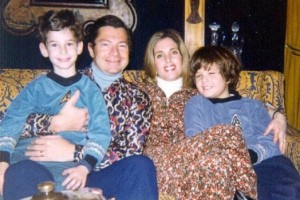
Of course, my love of Star Trek was known far and wide by my friends and family almost since I could walk and talk (and watch TV!). I used to draw little Enterprises on my homework in elementary school. I’d memorized nearly every line of the 79 original episodes by the time I’d reached ninth grade. I even joined STARFLEET, the international Star Trek fan association, back in 1983 and have been a member ever since.
In college and beyond, I would use VCR to record every episode of TNG and DS9 without commercials and then hand-label each VHS tape, color-coded by season. I had books, technical manuals, comics, toys, models, action figures…you know: all the stuff you probably have on your shelves, too. I published 27 issues of a newsletter called “Tricorder Readings” for the USS Avenger chapter of STARFLEET, and I even tried my hand (along with my friend Alex Rosenzweig) at creating blueprints of the USS Grissom from Star Trek III. So yeah, by the time I moved from to the West Coast, I was a total, certifiable geek…and damn proud of it!

As 1993 was drawing to a close, so was Star Trek: The Next Generation. It was in its final season, and work was ramping up on what would be the first Next Gen feature film. In addition, Deep Space Nine was still going strong, and a new series called Voyager was entering pre-production. Scenic Art Supervisor Michael Okuda (one of the nicest guys on the planet!) realized that his Star Trek art department would soon be short-staffed and overloaded. He needed someone quickly who was familiar with a Macintosh program called Macromind Director that his team at the time was using to create all of the 2D computer-interface animations that were seen in the background during episodes. This person also needed to be a trained graphic designer, experienced with Photoshop and used to working on tight deadlines.
Mike Okuda was friends with my good buddy at the time, Adam “Mojo” Lebowitz, who himself was busy doing 3D computer animation VFX with Foundation Imaging for the first season of Babylon 5. Mike asked Mojo if he’d consider doing some work at Paramount and joining the Trek team. Although Mojo loved Star Trek, he was needed full-time on B5. And besides, Mojo was more specialized in 3D than the 2D animations that Mike was doing back then. But Mojo did know someone who was really good at the stuff Mike needed, someone who knew Macromind Director, Photoshop, and was a trained graphic designer who loved Star Trek.
Mojo called me and asked how I’d like to work on Star Trek. Yeah, right! I was used to my friend’s pranks, but Mojo quickly convinced me this was all on the level. As I understood it, this would be a part-time gig, maybe 15 or 20 hours a week, which would leave me plenty of time to still work with my brother on building our small business. In the eleven months since we’d hung out our shingle, my brother and I had picked up a few clients–including NASA’s Jet Propulsion Laboratory–creating CD-ROMs and multimedia presentations for them. Sure, if I got hired by Mike Okuda, I’d be working hard at two jobs, but I could certainly handle it…especially if it meant being behind the scenes on Star Trek!
I set up an interview to meet with Mike at Paramount Studios on December 23, a few hours before he would be leaving for Oahu to visit his family for the holidays. If possible, Mike wanted someone to start right after New Years, so he was happy to have me come in quickly. He told me he had left a “drive on” at the gate for me to park on the lot, and the guard would direct me to his office.
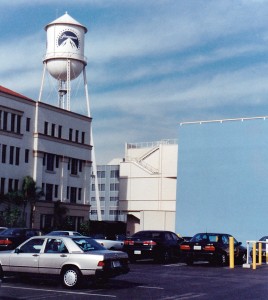
Let me tell you, having a “drive on” for the Paramount Pictures lot is one of the coolest things I’d ever experienced as a fan. For people at the studio, it’s no big deal. Someone calls down, leaves your name at the front gate, and they let you drive in and park on their property so you don’t have to pay for parking across the street at the structure on Van Ness Avenue. But for me, as I gazed up at that big blue wall that had been the backdrop when the Enterprise crew was climbing out of the sinking Klingon Bird-of-Prey that had crashed into San Francisco bay in Star Trek IV, I felt a just tingle (oh heck, it was a rush!) of fannish excitement. I was HERE!!! I was about to meet with Mike Okuda and quite probably even work on Star Trek! A “dream come true” was too small a phrase to describe what I was feeling as I walked the alleys between the sound stages, trying not to get lost.
And I did get lost…a few times. The Paramount lot is a frickin’ maze! And what was worse was that it was two days before Christmas, and there was almost no one to give me directions. A few folks sped past me on golf carts, too fast for me to stop them and ask which way I should go unless I wanted to get run over. But I finally found someone who pointed me to a flight of wooden stairs that looked more like some kind of maintenance ladder to a second-story door overlooking a huge sound stage filled with wood being cut and hammered into all manner of set pieces. This was the Star Trek scenic art department??? On the other hand, what was I expecting to see…the shuttlecraft landing port from the beginning of Star Trek: The Motion Picture?
Mike greeted me warmly and showed me around the small and cluttered area where the team worked. It didn’t look all that magical (it was actually kinda messy!), but I knew this was where an amazing amount of magic happened. The artistic look of Star Trek started right here on these very desks.
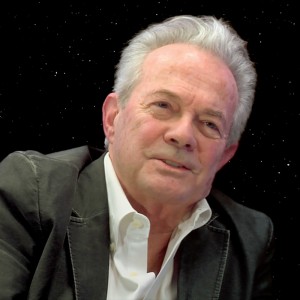
I brought along my resume and portfolio, and Mike was quite impressed (at least, I think he was). I had that really good feeling that you get when you just know you’re nailing your job interview. I kept my cool, but deep down, I was floating. We talked a little Trek, and at one point, Herman Zimmerman (art director and production designer) popped his head into Mike’s office, and Mike introduced me. I was trying not to gush, but man, it was so frickin’ cool!!!
It wasn’t a long interview, and Mike told me that the job was mine if I wanted it. Score!!! Now the only thing we needed to discuss was the hours. I asked which days of the week Mike would need me and what times? Mike looked confused. This was a full-time job, he explained, likely with union hours and lots of overtime and late nights.
Uh, oh.
I’m not sure where and when my misunderstanding happened, but in that moment, my heart sank. How could I just abandon my brother? There weren’t enough hours for me to work full-time at Paramount and also complete the design tasks our clients needed. And David couldn’t just fill in for me…his skills were in programming, not design. I’d typically meet with clients (during regular business hours) and sketch out design approaches for their projects. I couldn’t be at Paramount and on-site with clients at the same time…not even with a transporter!
I briefly considered whether David might be able to hire someone to replace me, but that would be tough. In order to build our small business, we were both working for a fraction of what any sane person would want as a salary. We likely couldn’t afford anyone with decent skills.
I asked Mike if there were any possibility for me to start working part-time and build up to full-time once my brother and I could figure out what to do about our clients. But I knew the answer even before the words left my mouth. I had to choose: my love of Star Trek or my loyalty to my brother David and the company we were building.
Filled with a sadness I can barely describe—even now, two decades later—I politely turned down my dream job, thanked Mike for meeting with me, and headed back to my car.
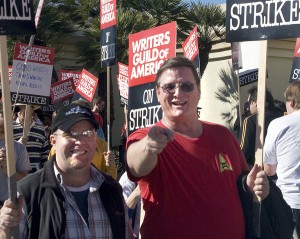
Eleven and a half years later, at the SAVE STAR TREK rally in front of Paramount’s main gate during filming for the final episode of Enterprise—picket sign in hand—I met James Van Over, the man whom Mike Okuda had hired for the full-time position.
During the rally, Jim had walked out to the main Paramount gate (like many on the Star Trek production team did that day) to see the hundreds of protesters lined up along Melrose Avenue. I noticed he’d come from inside the lot, and eager to chat with someone who worked on Trek, I asked what this friendly guy did on the show. “Oh, I work in the art department with Mike Okuda,” he answered.
“Really? When did you start working there?” I inquired.
Jim replied that it was back in early 1994. I laughed and said, “Oh, you got my job!” Seeing the confusion on his face, I told Jim my story, and when I finished, he mused, “Well, then I guess I should thank you for my house!” Jim and I have since become good friends, and he’s one of those nicest-guys-on-the-planet type of people. I’d glad that Mike Okuda was able to find such a good-natured and talented artist.
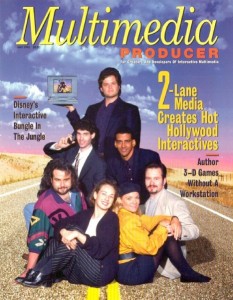
So, do I have any regrets? Believe it or not, the answer is no. I had the most amazing time running 2-Lane Media, Inc. with my brother for seven exciting years, working with dozens of fantastic designers and developers, winning over 70 industry awards, and helping in a small way to grow the World Wide Web out of its infancy. I wouldn’t trade that period of my life for anything.
And y’know what? The brief visit in 1993 wouldn’t be my last drive-on to the Paramount lot. In fact, I’d end up having a LOT more trips there. My dream of working professionally on Star Trek was still going to have a chance to come true. I just needed to wait two and a half more years until it happened.
To be continued…
